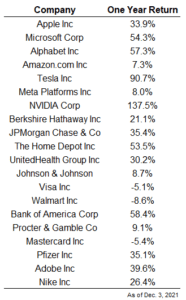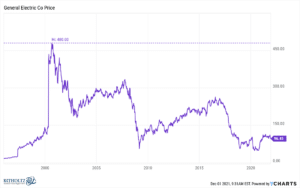As the year comes to a close in the next handful of days, I felt it would be appropriate to check in on the stock market and see how it’s performed this year. I also want to jump around to a few different market statistics I’ve recently found to be interesting.
It’s been a unique year for investors. Bitcoin started the year at $30,000 and is now over $50,000, GameStop became a global sensation, NFTs took the world by storm, and so much more as online investing has become more popular and more widespread. Although, I would guess that at the end of most years people look back and say, “Man, what a crazy year.”

Let’s start with the overall performance of a few different segments of the global stock market since January 1st:
• S&P 500 (large U.S. companies): 25%
• Russell 2000 (small U.S. companies): 15%
• Emerging Markets (Brazil, Russia, China, etc.): 0.25%
• Developed Markets (Canada, United Kingdom, Germany, etc.): 9%
• Total World Stock Index: 16%
*I’m writing this at the beginning of December, so by the time you’re reading it the numbers and percentages will have changed slightly.
If you’ve been invested in any of these indexes, minus emerging markets, or had a globally diverse portfolio this year, then congratulations! It’s been a good year for the stock market as a whole. Considering the long-term average return for the U.S. stock market is around 10% per year, a 25% gain is fantastic.
However, a yearly return of over 20% isn’t as uncommon as you might think. Over the past 90 years, the U.S. stock market has experienced a loss in 27% of the years and has experienced a gain of over 20% in 35% of the years. Meaning that you’re more likely to see a 20% gain in a given year than a loss.

While the stock market as a whole has performed well over the past year, the same can’t be said for each individual stock. The U.S. stock market is up roughly 25%, but one-third of all stocks have a negative return in that time. One out of every five stocks is down 20% or worse from its 52 week-high, and one out of every eight is down 30% or more.
Of the stocks that became available to publicly trade this year, commonly called IPOs, 49% of them are trading below their listing price. Exciting new stocks like Robinhood and Coinbase are down 35% and 12% respectively.
So, how can the stock market have such a positive return when so many of the stocks that make up the market are down? The reason is the biggest stocks, measured by total market value, have been on fire. Here’s a list of the top 20 names in the U.S. stock market and their recent returns:

The 20 biggest stocks currently make up around 35% of the index. And the average return of those 20 names over the past year is almost 35%. This is the tail that’s wagging the dog.
I know investors who feel like they can just buy a few of the most popular companies and outperform the overall market. While this has been true of late, the biggest stocks haven’t always been the biggest winners and it’s almost certain they won’t continue to be forever into the future. A good example of this is General Electric.
From 1980 to 2015 General Electric was one of the top 10 largest holdings in the S&P 500.That’s a long time to be one of the biggest stocks in the index. At the turn of the century, the stock price was as high as $480 but is now all the way down under $100. Meaning the stock price has fallen 80% from its peak:

History tells us that there are likely a few names in that current top 20 list that will suffer the same fate as General Electric.
Twitter is another example of how difficult individual stock picking can be. Jack Dorsey announced at the end of November that he’d be stepping down as CEO of the company and the stock actually jumped 12%. However, before that announcement, Twitter’s stock was up a whopping 2% since the company went public in 2013. How remarkable is that? Twitter is one of the most culturally relevant companies and used by hundreds of millions across the world, yet the stock has done nothing in eight years.

JP Morgan has a research report called The Agony & The Ecstasy where they examine the long-term difficulty of picking winners in the stock market. Some of the stats from this report are mind-blowing:
• More than 40% of stocks in the U.S. since 1980 have experienced a “catastrophic loss,” meaning the stock fell 70% from its peak and never reached those levels again.
• Pick any stock from the U.S. stock market and two-thirds of the time that stock would have underperformed the index itself.
• More than 40% of all stocks experienced negative returns on an absolute basis.
• Just 10% of stock since 1980 can be defined as mega-winners.
The point is, picking individual stocks is hard. You have a much higher probability of picking a mega-loser than a mega-winner in your portfolio. But because of survivorship bias, we hear far more stories about the winners than the losers. No one brags about the stock that lost them tons of money.
It’s been a tough year for a lot of stocks, but you wouldn’t know it by looking at the market as a whole. This is why I’m a big proponent of index funds and being diversified. This doesn’t mean that you should never pick individual stocks or that it doesn’t work out for some people. But it’s a hard game to play and is often time-consuming and emotionally exhausting.
You can’t argue with the data which pretty clearly states that beating the market, while possible, is a game that should mostly be played for fun.
Thanks for reading!

